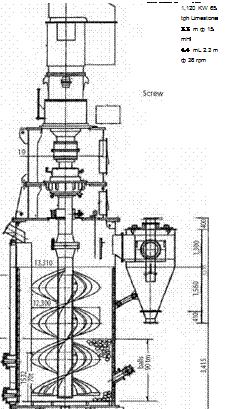As early as 1928 people started turning the hollow cylinder of the ball mill to a vertical position and started using a slow running agitator to keep the ball charge moving. The idea was to produce a uniform acceleration of the balls so that narrower particle size grinds results. (Netzsch 1974)
In stirred mills the balls and solid particles are kept in a state of continuous movement by an internal stirrer rather than by being tumbled. An important use of stirred mills is to grind limestone to make a slurry to remove sulfur oxides from flue gases.
The advantages of vertical stirred mills are that balls do not have to be elevated and that ball-to-ball and ball-to-wall collisions are much more rapid than in tumbling mills. Attrition is the important breakage mechanism in stirred mills, whereas impact is significant in tumbling mills. The early stirred mills were low speed, and these are still used for grinding at the coarse end of the very fine-grinding spectrum. Higher-speed stirred mills were developed later and are now extensively used for very fine-grinding processes.
What appears to have been the first serious attempt to use a vertical stirred ball mill in the mineral industry occurred during World War II in Japan when Isokichi Iwasaki observed the operation of a horizontal ball mill while working in the aluminum industry and recognized that it could be used in a vertical form as a well-stirred chemical reactor (Nitta 1998). Some time after 1945, he was given financial support by Asahi Glass Co. to manufacture a prototype mill that was to introduce the concept to the Japanese mineral industry. The ability of the mill to produce ultrafine particles at low power consumption was recognized by Taketora Kobayashi of Nitchitsu Mining Co., which joined with Asahi Glass Co. to design, manufacture, and test a production mill in 1953.
The mill was successful, but patent trouble occurred between the partners, and the Nippon Milling Company was formed in 1955 to continue the work. The vertical mill
 |
 |
became known as the Tower mill (Figure 8.2), and in 1965 the company was renamed the Japan Tower Mill Company. Many of the early Tower mills were used in mines in Japan for fine wet-grinding purposes, and it gained wide application for the comminution of limestone for neutralization purposes, such as in flue gas desulfurization plants and for acidic waters. In 1980, wet Tower mills were installed in Cominco’s lead/zinc and gold concentrators in Canada, and the mill was licensed to Koppers in the United States. Its main advantage in ore milling was that it could readily grind to about -25 pm and much finer if necessary. This was smaller than could be easily achieved by tumbling ball mills, which was a big advantage, but other benefits included low energy consumption, less noise, minimal vibration, and easy installation. By 1980, dry Tower mills were in use, and by 1990 ultrafine cement was being produced in them. In 1983, the Kubota Company, which had a large share of the market for grinding mills in Japan, acquired the Japan Tower Mill Company. By 1998, 242 mills had been sold in 15 countries, with the largest mill having a 1,120-kW motor and grinding 65 tph of limestone. In 1999, Nippon Eirich Co. Ltd. acquired the license for the Tower mill.
